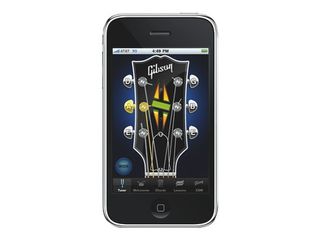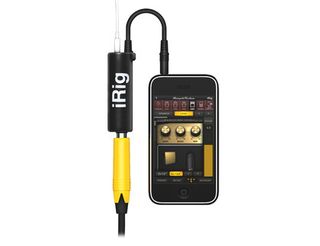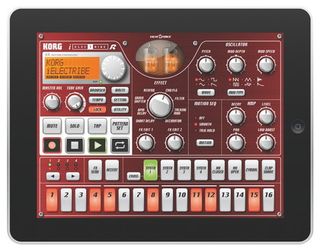How musicians are using the iPad
The professionals using iOS in the studio and on the road
With new music apps appearing daily and artists adopting the iPad as the ultimate studio partner, it's little surprise that major music software developers and legendary brands are starting to wake up to the potential of Apple's products.
Gibson has seen success by embracing iOS with its Learn & Master Guitar application, which recently won the Billboard Music App award. Partnering with Legacy Learning Systems, the guitar manufacturer has put together a unique resource for the iPhone that also serves as a great tool for accomplished guitarists.
With a built-in tuner that makes use of the iPhone's microphone as well as a metronome and chord library, the app offers an impressive feature set and also includes free video lessons from the Learn & Master Guitar series.

TUNE IN: Gibson's Learn & Master Guitar
Guitarists and bassists are well-served on the App Store with a wide range of apps, and a new breed of production tool is beginning to surface for today's musicians.
Peavey (a name synonymous with audio products) and IK Multimedia (producer of software and hardware music tools) both offer amplifier replacement apps for iOS that require a simple adaptor in order to connect a guitar or bass to the iPhone or iPad.
Removing the need for a physical amplifier or effects pedal, these apps have also wooed celebrity followers with their flexibility and impressive output for use in the studio, on-stage or just as a practice tool.
Get daily insight, inspiration and deals in your inbox
Get the hottest deals available in your inbox plus news, reviews, opinion, analysis and more from the TechRadar team.
Peavey's AmpKit app and AmpKit LiNK adaptor provide a dream combination for guitarists and bassists using the iPhone, providing a huge selection of pedals, cabs and mics as well as recording features, a tuner and metronome.
Peavey's AmpKit also offers in-app purchases for additional effects, and the company looks set to continue on iOS.
"Peavey is deeply committed to virtual instrumentation innovation," says Hartley Peavey, the company's founder and CEO.
"AmpKit and AmpKit LiNK open up an entirely new mobile paradigm for beginner and experienced musicians alike. I believe these innovative new products will give guitarists a whole new level of freedom and convenience – with AmpKit and AmpKit LiNK, anyone can access amazing guitar tone even when they don't have the space and time to set up a conventional rig."
Similarly, Dave Matthews Band bassist Stefan Lessard makes use of the popular AmpliTube and iRig adaptor from IK Multimedia to create and practice on the road.
"I love the look of AmpliTube on my iPad. It inspires me to practice," he says. "To be able to access sounds easily when writing music speeds up my creative abilities and allows me to hear what I want on the spot."

DREAM TEAM: AmpliTube and iRig
Lessard isn't the only music hero to make use of AmpliTube and iRig either, the software and adaptor combo has also been picked up by Nick Hexum of 311 and Richard Fortus of Guns N' Roses.
AmpliTube works in much the same way as Peavey's AmpKit LiNK adaptor, connecting a traditional guitar or bass to an iPad or iPhone. As with the AmpKit LiNK, the simple iRig adaptor plugs into the headphone jack of your device with the other end connecting to a guitar or bass. A third connection runs to your headphones or to a set of speakers to monitor playback.
It would certainly be possible for a band to play an entire set using this setup, and it's a neat option for smaller bands who can't move heavy equipment from gig to gig.
With the iPhone and iPad able to accurately reproduce the sound from a tour bus's worth of kit, it appears that the boundaries between traditional and software instruments are further blurred – but perhaps they could simply merge.
If you're familiar with the billboard chart of China's best concert pianists, you'll know of Lang Lang. The 26-year-old classical superstar is known for his impressive ivory tinkling, but this year he wowed the Davies Symphony Hall in San Francisco with his digital dexterity, playing Flight of the Bumblebee on an iPad as part of his encore.
Granted, he was using the idiot-proof Magic Piano from Smule with his right hand, but his left hand drifted toward his real piano's keys for parts of the performance to play along with the iPad.
Smule has been instrumental (ahem) in the development of the iPhone and iPad as a digital instrument. Founded by Dr Ge Wang and Jeff Smith, the company began life with Ocarina for iPhone, which lets the user blow into the microphone and play notes in the same way you would with a wind instrument.
From this starting point, the company picked up serious acclaim and the support of a major recording artist in T-Pain. The hip-hop star's famed Auto-Tune'd vocals are made available to the world with the I Am T-Pain app, which provides a number of presets to tweak a voice as well as recording facilities and backing tracks.
The unique take on mobile music, paired with T-Pain's celebrity status, saw widespread coverage on the web and TV, and earned plaudits from both the tech and music community.
The addition of such a big name in the music world certainly didn't harm the idea that music production and iOS were realistic partners and led Smule to the even bigger Glee app for iPhone and iPad, providing karaoke-style features based on the hit musical TV show.
Smule is also paving the way for digital music performance sharing with its apps, too. Ocarina, I Am T-Pain, Leaf Trombone and Glee all feature ways to get your music heard by broadcasting it to other users.
Starting with Ocarina, Smule has added a world map to its apps that shows different users across the globe playing a tune at that time – you simply tap the location to hear the song.
Like a sonic Twitter, this feature could well pave the way for similar sharing methods and become a great way for new bands to gain publicity outside of the usual channels.
Modern classics
Not only do classical artists appear to relish the iPad, but classical producers do as well. Alexander Van Ingen, a producer who has worked with an enormous list of clients, ranging from the London Philharmonic to the Winchester Cathedral Choir, and record labels such as Sony Music and Apex, uses an iPad on a day-to-day basis.
"I use it to aid my work on recording sessions, as well as to help with all the associated organisational stuff," he says.
"I use it mainly as a pitchfork and as a metronome, but I've also used it when rigging to keep track of mic lists, patching and so on – not to mention taking lists and using the GPS and maps to get me to the recording venue in the first place! It's also very handy for finding a curry house after recording."
Making use of Cleartune as a pitchfork and for pitch detection, Subdivide as a metronome and Mark Terry's Pianist Pro, Alexander sees the benefit of the all-in-one device: "It's made it slicker and simpler; fewer gadgets to remember to take with me, fewer boxes to have scattered around the desk when working and fewer items to run out of battery life, necessitating a scramble to find another pair of AA batteries."
Alex appreciates the way that some apps are interchangeable between devices. "I use a mixture of iPhone and iPad apps. Some of the iPhone apps work really well on the iPad; Cleartune, for example, would be even better with a dedicated iPad version but, as it is, it's nicer to use on the iPad than on the iPhone."
In comparison to using a laptop, Alexander is sold on the iPad's form factor and ease of use. "The interface is so much better, the whole Multi-Touch screen is great to use and the physicality of working with it is fantastic.
"I mean, you can hold it in your hand, put it in your lap, prop it up against a meterbridge… the form factor is super for ease-of-use around a studio, where a laptop just isn't so convenient. My MacBook Pro now feels a bit cumbersome after getting used to the iPad! And have you tried using a MacBook Pro for maps on the dashboard of your car?"
Another music hardware heavyweight, Korg, makes the iElectribe app, which turns the iPad into a virtual analogue beatbox. iElectribe's 16-step sequencer allows for simple groove creation using the ample space of the iPad's screen, and opens 10 years of instrument evolution to a whole new digital generation.

ELECTRIC DREAMS: Korg's iElectribe
Sean Foreman, of electropop outfit 3OH!3, makes use of the app when backstage or travelling, and feels it won't be long before iOS devices are more commonplace in music circles.
"Basically, iElectribe is an even more portable Korg Electribe R. The more compatible these programs become with computer software like Logic and Ableton, the more you'll see iPads in the studio or on stage," he said.
Mark Terry is in agreement. "For the future, I'm moving slightly away from novice musicians towards the professional sector for my userbase," he says. "This means more integration with the studio setup, with iPad apps offering additional musical tools rather than trying to be a replacement for existing kit."
Current page: Software over hardware
Prev Page How musicians are using the iPad Next Page The Logic leapMost Popular

